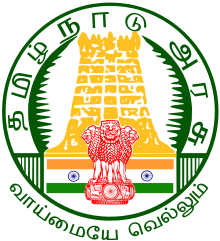Architecture of Tamil Nadu
Nearly 33,000 ancient temples, many at least 800 to 2000 years old, are found scattered all over Tamil Nadu. As per Tamil Nadu Hindu Endowments Board, there are 38615 Temples. Most of the largest Hindu Temples reside here.[3] Studded with complex architecture, variety of sculptures, and rich inscriptions, the temples remain the very essence of the culture and heritage of Tamil land, with historical records dating back to at least 3,000 years.
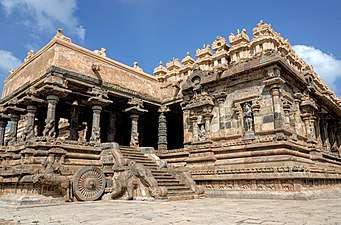
| Part of a series on |
| Tamils |
|---|
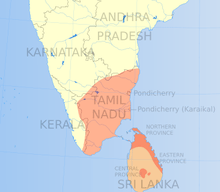 |
|
|
People
|
Tamil Australians, French Tamils, British Tamils, Tamil Italians, Tamil Indonesians, Tamil Canadians, Tamil Americans, Tamil South Africans, Myanmar Tamils, Tamil Mauritians, Tamil Germans, Tamil Pakistanis, Tamil Seychellois, Tamil New Zealanders, Swiss Tamils, Dutch Tamils |
|
Politics
|
|
|
The state also abounds with a large number of temple tanks. The state has 2,359 temple tanks located in 1,586 temples. and also confluence of many architectural styles. From ancient temples to the Indo-Saracenic style (pioneered in Madras) of the colonial era, churches, mosques to 20th-century steel and chrome of skyscrapers.[4]
History
Throughout Tamilakam, a king was considered to be divine by nature and possessed religious significance.[5] The king was 'the representative of God on earth’ and lived in a "koyil", which means the "residence of God". The Modern Tamil word for temple is koil. Titular worship was also given to kings.[6][7] Other words for king like "kō" "king"), "iṟai" "emperor") and "āṇḍavar" "conqueror") now primarily refer to God.[8] Tolkappiyar refers to the Three Crowned Kings as the "Three Glorified by Heaven".[9] In the Dravidian-speaking South, the concept of divine kingship led to the assumption of major roles by state and temple.[10]
Sangam period architecture
From 580BCE - 300CE, the greatest accomplishments of the kingdoms of the early Chola, Chera and the Pandyan kingdoms included brick shrines to deities murugan, Shiva, Amman and Vishnu. Several of these have been unearthed near Adichanallur, Kaveripoompuharpattinam and Mahabalipuram, and the construction plans of these sites of worship were shared to some detail in various poems of Sangam literature. One such temple, the Saluvannkuppan Murukan temple,[1][2] unearthed in 2005, consists of three layers. The lowest layer, consisting of a brick shrine, is one of the oldest of its kind in South India, and is the oldest shrine found dedicated to Murukan. It is one of only two brick shrine pre Pallava Hindu temples to be found in the state, the other being the Veetrirundha Perumal Temple at Veppathur dedicated to Lord Vishnu. The dynasties of early medieval Tamilakkam expanded and erected structural additions to many of these brick shrines. Sculptures of erotic art, nature and deities from the Meenakshi Temple, and Ranganathaswamy Temple date from the Sangam period. Many of the temples of this time have been built on either bricks or granite stones but they didn't survived till modern times due to the destruction caused by the invasion of the Dehli Sultanate Empire under the leadership of Malik Kafur.
Several brick structures dating to the Sangam era have been unearthed at places across Tamil Nadu such as keeladi, adichanallur and kodumanal. The findings at these sites indicate that the buildings were built using burnt bricks.[11]
Pallava architecture
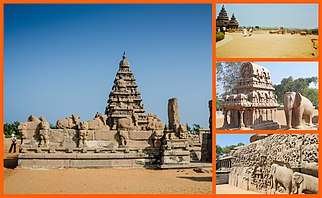
The Pallavas ruled from AD (600–900) and their greatest constructed accomplishments are the single rock temples in Mahabalipuram and their capital Kanchipuram, now located in Tamil Nadu.[12][13][14]
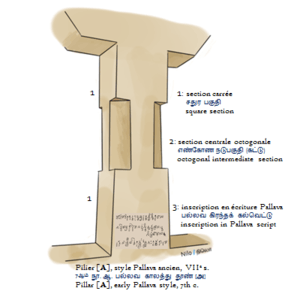
Pallava art and architecture represent an early stage of Dravidian art and architecture which blossomed to its fullest extent under the Chola Dynasty. The first stone and mortar temples of South India were constructed during Pallava rule and were based on earlier brick and timber prototypes.
The earliest examples of Pallava constructions are rock-cut temples dating from 610 – 690 CE and structural temples between 690 – 900 CE. A number of rock-cut cave temples bear the inscription of the Pallava king, Mahendravarman I and his successors.[15] The greatest accomplishments of the Pallava architecture are the rock-cut Group of Monuments at Mahabalipuram at Mahabalipuram, a UNESCO World Heritage Site, including the Shore Temple.[16][12][13] This group includes both excavated pillared halls, with no external roof except the natural rock, and monolithic shrines where the natural rock is entirely cut away and carved to give an external roof. Pallava sculptors later graduated to free-standing structural shrines which inspired Chola temples of a later age. Some of the best examples of Pallava art and architecture are the Kailasanathar Temple at Kanchipuram, the Shore Temple and the Pancha Rathas of Mahabalipuram. Akshara was the greatest sculptor of their time.[17][13][18]
Pandyan architecture

After the close of the Sangam age, the first Pandyan empire was established by Kadungon in the 6th century by defeating the Kalabhras, The empire ruled AD (6th – 10th century).
Rock cut and structural temples are significant part of pandyan architecture. The Vimana and mandapa are some of the features of the early Pandyan temples.[19] Groups of small temples are seen at Tiruchirappalli district of Tamil Nadu. The Shiva temples have a Nandi bull sculpture in front of the maha mandapa.[20] In the later stages of Pandyas rule, finely sculptured idols, gopurams on the vimanas were developed. Gopurams are the rectangular entrance and portals of the temples.[21][22] Meenakshi Amman Temple in Madurai and Nellaiappar Temple in Tirunelveli were built during the reign of the Pandyas.
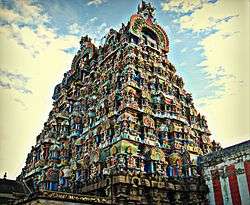
Nellaiappar Temple
Nellaiappar Temple is a Hindu temple dedicated to the deity Shiva, located in Tirunelveli, built by Pandyas and the sanctums of the temple were constructed by Nindraseer Nedumaran who reigned in the 7th century. The mani mandapam with its famous musical pillar was built by Later Pandyas in the 7th century.
Nellaiappar temple is spread over 14 acres. The gopuram of this temple is 850 feet long and 756 feet wide.[23] Sangili Mandapam built on 1647 by vadamalaiyappa pillayan connects the Ganthimathi Amman and Nellaiyappar temples.[24] From the inscriptions of Kulasekkara Pandiyan we learn that he defeated the Chera, Chola and Hoysala kings and built the outer walls of the temple with the war booty.[25]
Kalugumalai temples of Pandyas
The temples in Kalugumalai, a rocky hill in Thoothukudi district in southern Tamil Nadu. Kalugumalai houses the 8th century Jain Beds, Vettuvan Koil and Kalugasalamoorthy Temple, a Murugan temple at the foothills. The rock-cut temples, sculptures and the carvings are exemplary of early Pandyan architecture.[26] The Jain beds are dedicated to the Jain and Hindu religious figures. Constructed in rock cut style, the unfinished temple was built during the reign of Pandyan king Parantaka Nedunjadaiya (768-800 CE).
There are approximately 150 niches in the bed, that includes images of Gomateshwara, Parshvanatha and other Tirthankaras of the Jainism.[26]
The carvings in the Vettuvan Koil show the top portion of the temple, with an unfinished bottom. The sculptures and the carvings are indicative of Pandyan art during the period.[26] The granite rock looks like a blooming lotus, with hills surrounding it on three sides. The vimana (ceiling over the sanctum) has niches of Parsavadevatas, the attendant deities of Shiva, like ganas, Dakshinamurthy depicted playing a mridanga, Siva with his consort Uma, dancers, various niches of Nandi (the sacred bull of Shiva) and animals like monkeys and lions. Historian Sivaramamurti believes that this is the only place where
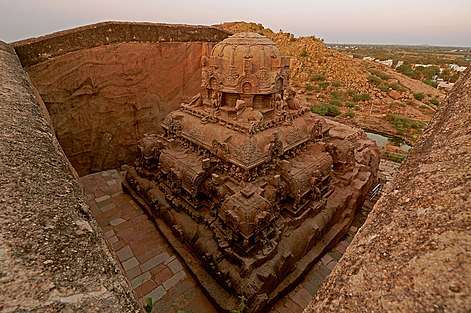
Dakshinamurthy is depicted playing the Mridanga (a percussion instrument), while in all other places, he is depicted playing Veena. Epigrapher like V. Vedachalam believes that there is a spontaneity in the sculptures indicating of natural human movements like in
.jpg)
the Shiva and Uma sculpture where they seem to be talking like common folks.
The sanctum of the Kalugasalamoorthy temple is approached through a pillared hall near the gateway. The temple tank is located outside the temple. The sanctum is built in a rock-cut cave, which houses the image of Murugan in the form of Kazhugachalamurthi in seated posture. The sanctum faces West and the image of the presiding deity is 4 ft (1.2 m) tall. The image is sported with six hands with one of them holding Vel (divine spear), his left leg over the shoulder of the peacock and right is left hanging. There are separate shrines of his consorts Valli facing South and Deivanai facing North. There is a separate shrine for Shiva and Parvathi and all the Parsvatah Devatas (attendant deities) associated with Shiva temples. Usually in Murugan temples, his vehicle peacock would be heading towards his right, but it is sported on to the left of Murugan in this temple. It is believed that Indra, the king of celestial deities, appeared as peacock to worship Murugan. The image of the peacock is hence covered during the festivals.[27]
Chola architecture

The Chola kings ruled from AD (848–1280) and included Rajaraja Chola I and his son Rajendra Chola who built temples such as the Brihadeshvara Temple of Thanjavur and Brihadeshvara Temple of Gangaikonda Cholapuram, the Airavatesvara Temple of Darasuram and the Sarabeswara (Shiva) Temple, also called the Kampahareswarar Temple at Thirubhuvanam, the last two temples being located near Kumbakonam. The first three among the above four temples are titled Great Living Chola Temples among the UNESCO World Heritage Sites.
The Cholas were prolific temple builders right from the times of the first king Vijayalaya Chola after whom the eclectic chain of Vijayalaya Chozhisvaram temple near Narttamalai exists. These are the earliest specimen of Dravidian temples under the Cholas. His son Aditya I built several temples around the Kanchi and Kumbakonam regions.
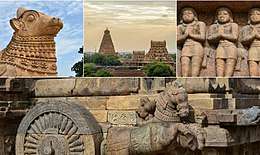
Temple building received great impetus from the conquests and the genius of Aditya I Parantaka I, Sundara Chola, Rajaraja Chola and his son Rajendra Chola I. Rajendra Chola 1 built the Rajaraja Temple at Thanjur after his own name. The maturity and grandeur to which the Chola architecture had evolved found expression in the two temples of Tanjavur and Gangaikondacholapuram. He also proclaimed himself as Gangaikonda. In a small portion of the Kaveri belt between Tiruchy-Tanjore-Kumbakonam, at the height of their power, the Cholas have left over 2300 temples, with the Tiruchy-Thanjavur belt itself boasting of more than 1500 temples. The magnificent Siva temple of Thanjavur built by Raja Raja I in 1009 as well as the Brihadisvara Temple of Gangaikonda Cholapuram, completed around 1030, are both fitting memorials to the material and military achievements of the time of the two Chola emperors. The largest and tallest of all Indian temples of its time, the Tanjore Brihadisvara is at the apex of South Indian architecture.[28] In fact, two succeeding Chola kings Raja Raja II and Kulothunga III built the Airavatesvara Temple at Darasuram and the Kampahareswarar Siva Temple at Tribhuvanam respectively, both temples being on the outskirts of Kumbakonam around AD 1160 and AD 1200. All the four temples were built over a period of nearly 200 years reflecting the glory, prosperity and stability under the Chola emperors.
Contrary to popular impression, the Chola emperors patronized and promoted construction of a large number of temples that were spread over most parts of the Chola empire. These include 40 of the 108 Vaishnava Divya Desams out of which 77 are found spread most of South India and others in Andhra and North India. In fact, the Sri Ranganathaswamy Temple in Srirangam, which is the biggest temple in India (**) and the Chidambaram Natarajar Temple (though originally built by the Pallavas but possibly seized from the Cholas of the pre-Christian era when they ruled from Kanchi) were two of the most important temples patronized and expanded by the Cholas and from the times of the second Chola King Aditya I, these two temples have been hailed in inscriptions as the tutelary deities of the Chola Kings.
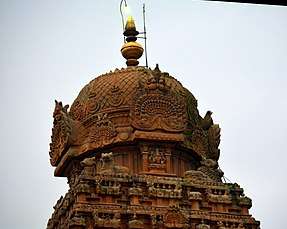
Temple shrine on the Koneswaram temple promontory extremity and the Ketheeswaram temple and Munneswaram temple compounds contained tall gopuram towers by Chola rule of Trincomalee, Mannar, Puttalam and Chidambaram's expansion that escalated the building of those syncretic latter styles of Dravidian architecture seen across the continent pictured.[29][30][31][32]
Of course, the two Brihadisvara Temples at Thanjavur and Gangaikonda Cholapuram as well as the other two Siva temples, namely the Airavatesvara Temple of Darasuram and the Sarabeswara (Shiva) Temple which is also popular as the Kampahareswarar Temple at Thirubhuvanam, both on the outskirts of Kumbakonam were the royal temples of the Cholas to commemorate their innumerable conquests and subjugation of their rivals from other parts of South India, Deccan Ilangai or Sri Lanka and the Narmada-Mahanadi-Gangetic belts. But the Chola emperors underlined their non-partisan approach to religious
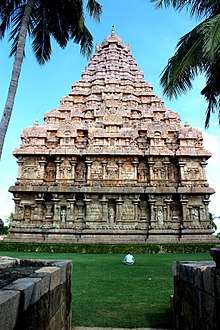
iconography and faith by treating the presiding deities of their other two peerless creations, namely the Ranganathaswamy Temple dedicated to Lord Vishnu at Srirangam and the Nataraja Temple at Chidambaram which actually is home to the twin deities of Siva and Vishnu (as the reclining Govindarajar) to be their 'Kuladheivams' or tutelary (or family) deities. The Cholas also preferred to call only these two temples which home their tutelary or family deities as Koil or the 'Temple', which denotes the most important places of worship for them, underlining their eq. The above-named temples are being proposed to be included among the UNESCO World Heritage Sites, which will elevate them to the exacting and exalting standards of the Great Living Chola Temples.
The temple of Gangaikondacholapuram, the creation of Rajendra Chola I, was intended to exceed its predecessor in every way. Completed around 1030, only two decades after the temple at Thanjavur and in much the same style, the greater elaboration in its appearance attests the more affluent state of the Chola Empire under Rajendra.[33] This temple has a larger Siva linga than the one at Thanjavur but the Vimana of this temple is smaller in height than the Thanjavur vimana.
The Chola period is also remarkable for its sculptures and bronzes all over the world. Among the existing specimens in museums around the world and in the temples of South India may be seen many fine figures of Siva in various forms, such as Vishnu and his consort Lakshmi, and the Siva saints. Though conforming generally to the iconographic conventions established by long tradition, the sculptors worked with great freedom in the 11th and the 12th centuries to achieve a classic grace and grandeur. The best example of this can be seen in the form of Nataraja the Divine Dancer.[34]
Vijayanagara and Nayak architecture
Vellore Fort
Vellore Fort was built by Chinna Bommi Reddy and Thimma Reddy Nayak, subordinate chieftains under Sadasiva Raya of the Vijayanagara Empire in the year of 1566 AD.[35] It is mentioned that "there is no such fort on the face of earth like the one in Vellore. It had a deep wet ditch (moat) where once 10,000 crocodiles swarmed, waiting to grab every intruder into this impregnable fort. It has huge double walls with bastions projecting irregularly, where two carts can be driven abreast".[36] The fort was constructed in granite from the nearby quarries in Arcot and Chittor districts. It spreads over an area of 133 acres (0.54 km2) and is located at an altitude of 220 m (720 ft) within a broken mountain range. The fort is surrounded by a moat which was once used as an additional line of defence in the case of an invasion. It was supposed to have included an escape tunnel leading to Virinjipuram about 12 km (7.5 mi) away, which could be used by the king and other royals in the event of an attack. This report was however later disputed by researchers of the ASI who found no evidence of the existence of such a passage. The fort is considered to be among the best of military architecture in Southern India and is known for its grand ramparts, wide moat and robust masonry.[37] The Jalakanteshwara Temple inside Vellore fort is a fine example of Vijayanagaram Architecture. The temple has exquisite carvings on its gopuram (tower), richly carved stone pillars, large wooden gates and stunning monoliths and sculptures. These Vijayanagara sculptures are similar to the ones present in Soundararajaperumal Temple, Thadikombu, Krishnapuram Venkatachalapathy temple, Srivilliputhur Divya Desam and Alagar Koyil.[38] The Gopuram of the tower is over 100 ft. in height. The temple also has a Mandapam, with the hall supported by carved stone pillars of dragons, horses and yalis (lion like creature).[39][40]
.jpg)
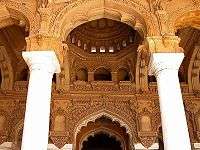
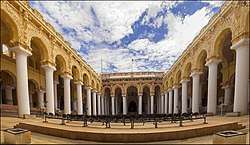

The Madurai and Tanjavur Nayaks made great contributions to architectural style, the main characteristics of the style during this period being the elaborate mandapas of the "hundred-pillared" and "thousand-pillared" types, the high gopurams with stucco statues on the surface and the long corridors.
The main temples representing this style are:
- The Ranganatha temple at Srirangam – noted for its increase in the number of enclosures;
- The temple at Rameswaram – noted for its long corridors;
- The Subramanya temple at the Brihadisvara Temple court at Tanjavur – noted for its fine vimana with ratha and maha mandapas;
- Meenakshi Temple at Madurai – noted for the great splendour its "thousand-pillared" mandapam, and the Thanga Thamarai kulam ("Golden Lotus water pool").
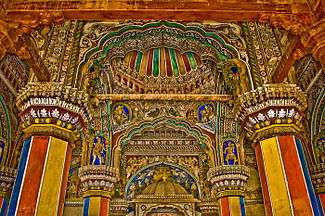
Thanjavur Maratha kingdom
The Thanjavur Maratha palace was originally constructed by the rulers of Thanjavur Nayak kingdom. After the fall of the Thanjavur Nayak kingdom, it served as the official residence of the Thanjavur Maratha. The palace complex consists of the Sadar Mahal Palace, the queen's courtyard and the Durbar Hall. The Royal Palace Museum contains a splendid collection of Chola bronzes. The Raja Serfoji Memorial Hall and the Royal Palace Museum are situated in the Sadar Mahal Palace. There is also a small bell tower. The Saraswathi Mahal Library is situated with the Thanjavur palace complex.[41]
Colonial
San Thome Basilica is a Roman Catholic (Latin Rite) minor basilica in Santhome, in the city of Chennai (Madras), India. It was built in the 16th century by Portuguese explorers, and rebuilt again with the status of a cathedral by the British in 1893.
The Madras High Court and Government Museum in Chennai were designed by Henry Irwin.
Indo-Saracenic architecture
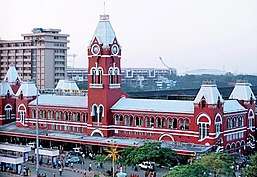
Indo-Saracenic architecture is a type of architecture used by the British architects in India in the late 19th century and the early 20th century. It is a combination of Islamic, Hindu, and Byzantine architecture. Features of Indo-Saracenic architecture include domes, arches, minarets, and stained glass. The British built many public buildings like museums, educational institutions, and railway stations using this type of architecture. Examples of Indo-Saracenic style buildings in Chennai include Madras High Court, Senate House, Chepauk Palace, and Egmore Railway station.[42]
Notable buildings in Chennai
Many historic buildings are still fully functional and host government, business or educational establishments. Chennai is home to the second largest collection of heritage buildings in the country, after Kolkata.[43]
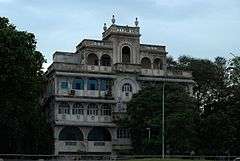
Fort St. George
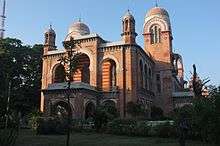
Built in 1639, Fort St George, used to house the Tamil Nadu Legislative Assembly and Secretariat. Tipu Sultan's cannons decorate the ramparts of the Fort's museum. The Fort has the country's tallest flagstaff at a height of 150 feet.[44] The fort is one of the 163 notified areas (megalithic sites) in the state of Tamil Nadu.
Chepauk Palace
Constructed in 1768, it was the first building in India constructed using the Indo-Saracenic type of architecture. It was designed by Paul Benfield, a British architect.[42] The Chepauk Palace used to be the official residence of the Nawabs of Arcot. It has a total area of 117 acres with two blocks - Kalas Mahal and Humayun Mahal.[45]
Senate House
Constructed in 1879 by Robert Chisholm,[46] the Senate House is located inside the University of Madras campus and represents the Indo-Saracenic style of architecture. The main door of the Senate House opens to the Great Hall which is 150 feet long, 60 feet wide, and 50 feet high. The first Legislative Assembly of Madras met here in 1937. University convocations were also previously held here.[46]
Madras High Court
The Madras High Court is the second largest judicial building in the world next only to the Courts of London. It is a good example of the Indo-Saracenic style and was completed in 1892.[47]
National Art Gallery
The Victoria Memorial Hall built in 1906 by Henry Irwin[48] is another example of Indo-Saracenic architecture. It was initially the location of the Victoria Technical Institute, later renamed as the National Art Gallery in 1951.[49] It had about 175 collections of paintings from Rajasthan, Deccan, Tanjore, and Raja Ravi Varma, besides many bronze, wood, and ivory items from the British era. However, the art gallery is closed since 2002 as it is being renovated.[48]
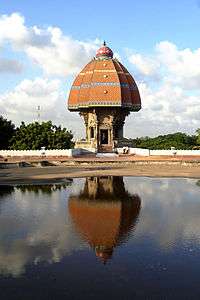
Valluvar Kottam
The Valluvar Kottam, constructed in 1976, is an auditorium in memory of the poet-saint Thiruvalluvar. All 1,330 verses of the poet's epic, the Thirukkural, are inscribed on the granite pillars that surround the auditorium. There is a 101-feet high temple chariot structure with a life-size image of the poet in it. The base of the chariot shows in bas-relief the 133 chapters of the Thirukkural.
Railway stations
There are a number of railway stations of interest in Chennai, primarily built throughout the colonial era. These include the Egmore station, the Royapuram station dating from 1856, the Chennai Central station dating from 1873 and the Southern Railway Headquarters built in 1922.
Other interesting buildings
The Government Museum (designed by Henry Irwin and completed in 1896) and the College of Engineering, Guindy are some more examples of the Indo-Saracenic style of architecture.
Other buildings of architectural significance are the Presidency College, built in 1840, the Ripon Building (now housing the Chennai Corporation) dating from 1913, The War Memorial, Vivekanandar Illam, The Museum Theatre and the Ramakrishna Math temple. Adjoining the Governor's residence (Raj Bhavan) at Guindy, there are five mandapams (or memorials) dedicated to Mahatma Gandhi, the first Indian Governor General C Rajagopalachari, former Chief Ministers of the state Kamaraj and Bhaktavatsalam and one to Martyrs in general.
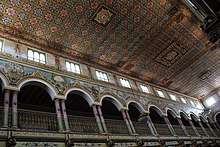
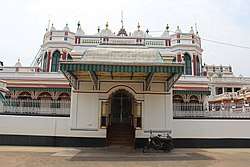
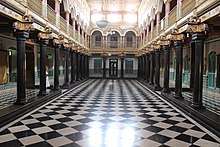
Chettinad architecture
Chettinad is a region located mainly in the Sivaganga district ruled by Ramnad kingdom of Pandya Nadu and has a small portion extending into the Pudukottai District of Chola Nadu in Tamil Nadu, India.
The Chettinad region is well known for its 19th-century mansions, whose wide courtyards and spacious rooms are embellished with marble and teak. Construction materials, decorative items and furnishings were mostly imported from East Asian countries and Europe. The marble was brought from Italy, chandeliers and teak from Burma, crockery from Indonesia, crystals from Europe and wall-to-wall mirrors from Belgium.
Many of these mansions were built using a type of limestone known as karai.[50] Local legend has it that the mansion walls were polished with a paste made out of eggwhites to give them a smooth texture.
Post-Independence
After Independence, the state witnessed a rise in a blend of Modern and Traditional style of architecture.[51]
Notable Post-Independence Buildings
Gandhi Mandapam
Built in 1956, the Gandhi Mandapam is a set of memorials dedicated to Mahatma Gandhi and numerous other Chief Ministers of Tamil Nadu. Its total area is 18 acres and it contains an amphitheater and a museum.[52] The memorial is unique as it is modelled in the style of a South Indian temple.
Vivekananda Rock Memorial
The Vivekananda Rock Memorial was constructed in 1970[53] in the memory of Swami Vivekananda. It is located on an island near Kanyakumari next to the Thiruvalluvar Statue. Eknath Ranade, a social activist who was influenced by the teachings of Swami Vivekananda, played a crucial role in the construction of the memorial. He also founded the Vivekananda Kendra adjacent to the memorial in 1972.[54]
Thiruvalluvar Statue
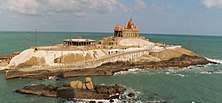
The Thiruvalluvar Statue, whose construction started in 1990 and completed in 1999,[55] is a 133-feet high (statue height 95 feet erected on a 38 feet stone pedestal[53]) dedicated to the Tamil poet Thiruvalluvar, who wrote Thirukkural, considered one of the greatest works in literature of morality and ethics. The height signifies the 133 chapters of Thirukkaral. The statue is located on an island near the southern most city of mainland India, Kanyakumari. It was constructed by Ganapati Sthapati.[55]
Gallery
| Wikimedia Commons has media related to Architecture of Tamil Nadu. |
See also
- List of temples in Tamil Nadu
- Architecture of India
- Chola Architecture
- Pallava Architecture
- Architecture of Chennai
References
- N. Subramanian (21 September 2005). "Remains of ancient temple found". The Hindu. Archived from the original on 10 November 2012.
- N. Ramya (1 August 2010). "New finds of old temples enthuse archaeologists". Times of India.
- "Tamil Nadu, Andhra Pradesh build temple ties to boost tourism". The Times of India. 10 August 2010. Archived from the original on 14 July 2012. Retrieved 21 September 2011.
- "Mission to Renovate Temple Tanks". The Deccan Chronicle. Chennai: The Deccan Chronicle. 19 May 2013.
- Harman, William P. (1992). The sacred marriage of a Hindu goddess. Motilal Banarsidass. p. 6.
- Anand, Mulk Raj (1980). Splendours of Tamil Nadu. Marg Publications. p. 146.
- Chopra, Pran Nath (1979). History of South India. S. Chand. p. 49.
- Bate, Bernard (2009). Tamil oratory and the Dravidian aesthetic: democratic practice in south India. Columbia University Press.
- A. Kiruṭṭin̲an̲ (2000). Tamil culture: religion, culture, and literature. Bharatiya Kala Prakashan. p. 17.
- Embree, Ainslie Thomas (1988). Encyclopedia of Asian history: Volume 1. Scribner. ISBN 9780684188980.
- Jesudasan, Dennis S. (20 September 2019). "Keezhadi excavations: Sangam era older than previously thought, finds study". The Hindu. ISSN 0971-751X. Retrieved 22 September 2019.
- James G. Lochtefeld (2002). The Illustrated Encyclopedia of Hinduism: A-M. The Rosen Publishing Group. p. 399. ISBN 978-0-8239-3179-8.
- "Group of Monuments at Mahabalipuram". UNESCO.org. Retrieved 23 October 2012.
- "Advisory body evaluation" (PDF). UNESCO.org. Retrieved 23 October 2012.
- Nilakanta Sastri, pp412–413
- Mamallapuram, Encyclopedia Britannica
- Nilakanta Sastri, p139
- Group of Monuments at Mahabalipuram, Dist. Kanchipuram Archived 2018-05-29 at the Wayback Machine, Archaeological Survey of India (2014)
- Desai, Pandurang Bhimarao (1971). Studies in Indian history and culture: volume presented to Dr. P. B. Desai ... on the occasion of his completing sixty years. Prof. P. B. Desai Felicitation Committee, Karnatak University; [for copies write to the printer: K. E. B's Print. Press]. p. 125.
- Rajan, K. V. Soundara (1 March 1998). Rock-cut temple styles: early Pandyan art and the Ellora shrines. Somaiya Publications. p. 58. ISBN 9788170392187.
- Allen, Margaret Prosser (1991). Ornament in Indian Architecture. University of Delaware Press. p. 350. ISBN 9780874133998.
- Mansingh, Surjit (9 May 2006). Historical Dictionary of India. Rowman & Littlefield. p. 430. ISBN 9780810865020.
- "Muthuswami Dikshithar". Retrieved 28 April 2015.
- Thirukkoilkal vazhikaatti, Tirunelveli District; tnhrce; August 2014;page 11
- "Archived copy". Archived from the original on 19 December 2017. Retrieved 2 October 2019.CS1 maint: archived copy as title (link)
- "Sthala Varalaru". Hindu Religious and Endowment Board, Government of Tamil Nadu. 2015. Retrieved 4 November 2015.
- "Sri Kazhugachalamurthi Temple". Dinamalar. 2011. Retrieved 4 November 2015.
- See Nilakanta Sastri, K.A. (1955). A History of South India, pp 421
- K.A. Nilakanta Sastri, A History of South India, pp 424–426
- Karen Schreitmuller (2012). Baedeker India, pp. 90
- Perniola, V. "The Catholic church in Sri Lanka. The Portuguese period", vol. II, p. 366.
- Bastin, Rohan. The domain of constant excess : plural worship at the Munnesvaram temples in Sri Lanka. pp. 114
- Nagasamy R, Gangaikondacholapuram (1970)
- The bronze image of nataraja at the Nagesvara Temple in Kumbakonam is the largest image known.
- "Rediscovering the tomb of our last king". Sunday Times. March 2012. Retrieved 10 October 2013.
- "The town with the "healing touch"". The Tribune India. 28 April 2002. Retrieved 10 October 2013.
- "Historic monuments in Vellore district". Vellore District Administration. Archived from the original on 6 February 2012. Retrieved 10 October 2013.
- S., Gopalakrishnan (December 1996). "The Raṅga-maṇḍapa of the Tāṭikkompu Temple A Study of an Iconographic Programme of the Vijayanagara Tradition". East and West. 46 (3/4): 415–431. JSTOR 29757285.
- "An Ancient Wonder : Vellore, Tamil Nadu's Fort City". Maps of India. 19 September 2011. Retrieved 19 August 2015.
- "Vellore Fort". Vellore Online. 2009. Retrieved 19 August 2015.
- Gopal, Madan (1990). K.S. Gautam (ed.). India through the ages. Publication Division, Ministry of Information and Broadcasting, Government of India. p. 185.
- Jeyaraj, George. "Indo Saracenic Architecture in Chennai" (PDF).
- Ravishankar, Sandhya (6 September 2007). "No fire safety norms at Chennai heritage buildings". IBN Live. Chennai: CNN IBN. Retrieved 20 November 2012.
- "Fort St. George, Chennai". Mapsofindia.com. Retrieved 25 January 2013.
- Lakshmi, K. (22 August 2017). "Chepauk Palace, an iconic structure". The Hindu. ISSN 0971-751X. Retrieved 31 March 2019.
- Alexander, Deepa (26 February 2019). "Chennai's Senate House opens its doors to the public". The Hindu. ISSN 0971-751X. Retrieved 30 March 2019.
- "chennai tourism | chennai tourist | chennai tourist places | chennai tourist spots | tourist spots in chennai | highcourtbuilding.html". Chennai-directory. Archived from the original on 5 June 2013. Retrieved 25 January 2013.
- Madhavan, D. (15 April 2016). "National Art Gallery getting a facelift". The Hindu. ISSN 0971-751X. Retrieved 31 March 2019.
- Reporter, Staff (20 October 2013). "Chennai heritage building gets Rs. 11 cr". The Hindu. ISSN 0971-751X. Retrieved 31 March 2019.
- "About Karaikudi". cecri.res.in. Retrieved 22 September 2013.
- V, Sriram (15 August 2014). "Art Deco in a crowded city". The Hindu. ISSN 0971-751X. Retrieved 16 June 2019.
- Lakshmi, K. (7 September 2013). "Renovation of Gandhi Mandapam nears completion in Chennai". The Hindu. ISSN 0971-751X. Retrieved 31 March 2019.
- ":::TTDC - Places:::". www.tamilnadutourism.org. Retrieved 30 March 2019.
- "The Magnificent Vivekananda Rock Memorial Stands Solidly In Honour Of Swami Vivekananda". www.culturalindia.net. Retrieved 30 March 2019.
- "Saint Thiruvalluvar Statue, Kanyakumari (Entry Fee, Timings, Entry Ticket Cost, Phone, Price) - Kanyakumari Tourism 2019". kanyakumaritourism.in. Retrieved 30 March 2019.
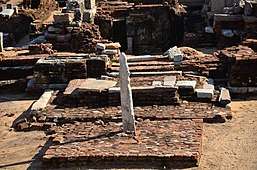
_witnessed_by_Vishnu%2C_Meenakshi_Temple%2C_Madurai_(3)_(37479149336).jpg)
